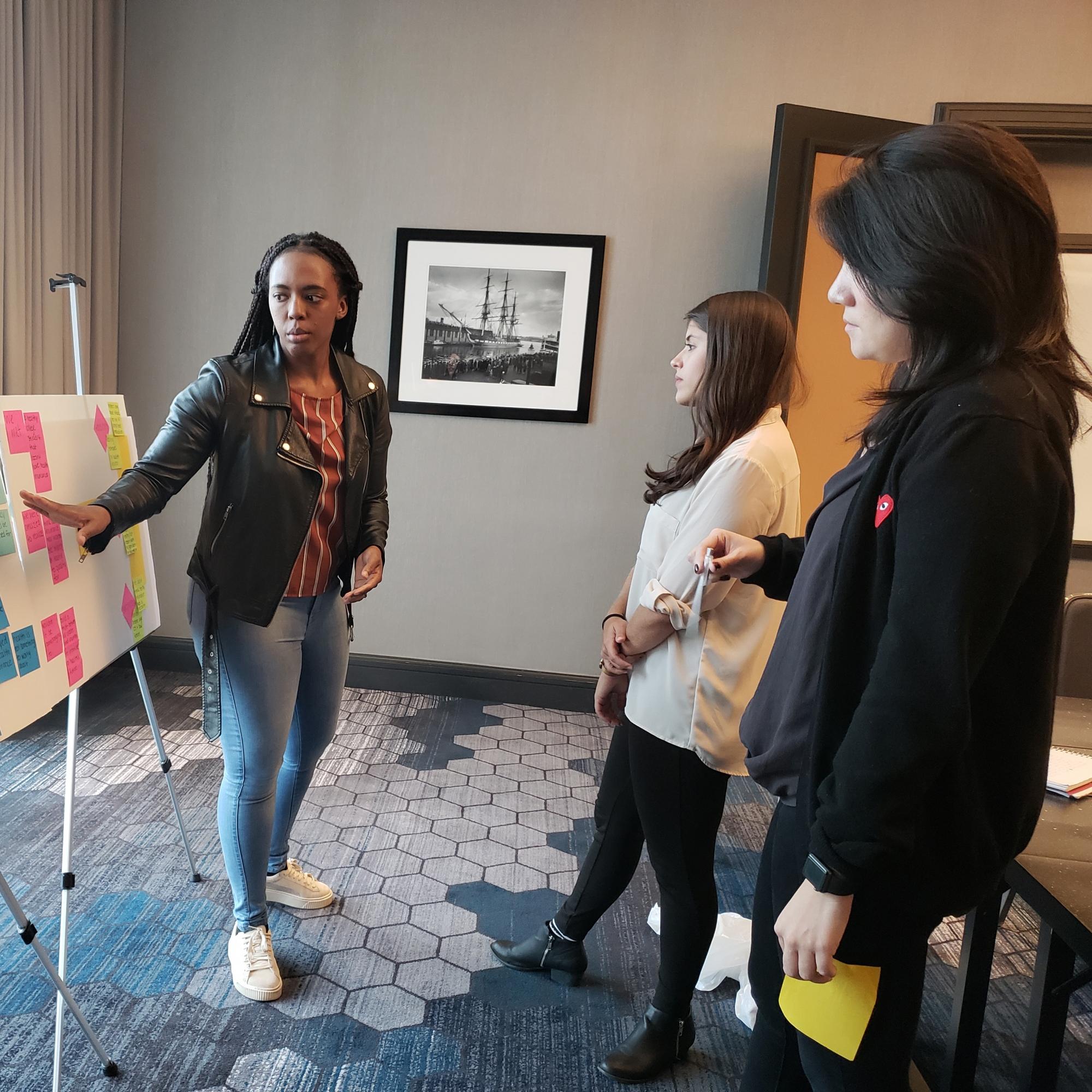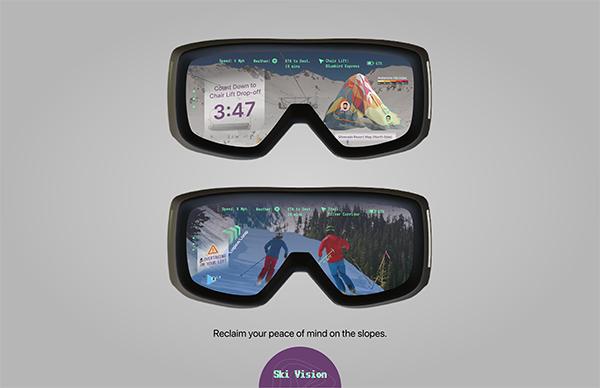Interaction Design
BACHELOR OF FINE ARTS | BACHELOR OF ARTS
Shape new technologies and design solutions for problems that matter.
The Corcoran Design Program explores the intersection of design, innovation, public communications, and the social impacts of technologies in the nation’s capital, at a critical moment in the history of cultural discourse and design practice.
Our degree programs in Interaction Design engage students in critical thinking and problem-solving to re-imagine how individuals and communities use and engage with technology, access information and experience designed services. The program offers a Bachelor of Fine Arts (B.F.A.) and a Bachelor in Arts (B.A.). Both degree options focus on product design, creative coding, prototyping, user experience, design research, storytelling and ethics.The B.F.A. degree allows students to dive deeply into Interaction Design within the context of a comprehensive art and design education. The B.A. degree allows students to connect design coursework with other areas of study. Interaction Design is a diverse field well matched with multidisciplinary study, including double majoring in related fields.
At the Corcoran School of the Arts + Design, you’ll find yourself embedded in a creative community where designers, artists, photojournalists, musicians and performers connect in the classroom and beyond. You can take advantage of a world-class research institution at the George Washington University to engage in interdisciplinary practices that can expand your vision of what design can do and enhance your capacity to realize your ideas.
The Corcoran Design Program offers two degrees options in Interaction Design:
- A bachelor of fine arts (BFA) in Interaction Design
- A bachelor of arts (BA) in Design with a concentration in Interaction Design
Corcoran Design also offers opportunities to study graphic design.
PROSPECTIVE STUDENTS
INFORMATION SESSIONS
Each academic year, we offer virtual information sessions led by faculty to help prospective students learn more about our programs, faculty expertise, and application process.
WHAT YOU'LL CREATE
Students present early user research data at Centers for Medicare and Medicaid for a design collaboration exploring how schools might serve as healthcare access locations.
Interaction Design students explore original documentation from a 1978 Chicago Field Survey as part of a project that studies digital access to archival materials held in the American Folklife Center at the Library of Congress. Using the Field Survey's original field notes, photographs, ephemera, and recordings, students developed new strategies to increase public accessibility to the collection.
WHAT YOU'LL STUDY
Corcoran's degree programs in Interaction Design focus on building compelling relationships between people and the systems around them. We re-imagine how individuals and communities use and engage with technology, access information and experience designed services. Our students connect their work to many areas of work from creative technologies, to
To prepare our students for this demanding and dynamic field, Corcoran Interaction Design programs immerse students in a foundation of applied skills (including communication design, prototype development and coding interfaces for the mobile web) alongside study in user experience and research processes that are at the heart of interaction design work (such as user research, information architecture, systems thinking, and project development).
This work culminates in the Engagement Lab, where students deepen their capacity to contextualize their work and design social impacts that are more just and reflective of community needs. That might include looking for ways to create access and make technology work for all the different people who use it or using design processes to examine institutional cultures and policies to deliver better outcomes for all stakeholders involved.
Small class settings and feedback processes focused on individual student needs provide you the conceptual, technological and communication tools to excel as a working professional in design. Each class functions as a laboratory addressing case studies and prepares students to take on current challenges that are important to them and their career trajectories.
BFA in Interaction Design
The B.F.A. degree allows students to dive deeply into Interaction Design within the context of a comprehensive art and design education. The degree program begins with a strong foundation in design principles and digital technologies, then progresses to more specialized courses in that combine pragmatic skills with high-level thinking and creativity The BFA immerses students in applied skills such as interface design, prototype development, and coding, as well as the conceptual processes of project development, leadership, and systems thinking. The BFA is an education in creative technology that situates tech skills in frameworks that activate creativity, equity, and social justice. Each class functions as a laboratory addressing case studies and prepares students to take on challenges that are important to them and their career trajectories. The culminating experience of the program is a two-semester thesis project during the final year, which is exhibited at NEXT.
The BFA degree path requires 69 credits of design, art, and art and design history courses. All students are required to complete a minor in an outside field (typically 18 credits). Choose a minor that complements your design work in any way you choose - whether that is by focusing on an area you might want to work within as designer, expanding your creative skills in a Corcoran minor, or developing complementary knowledge in an area of interest.
BFA Interaction Design Course Requirements
BA with a concentration in Interaction Design
Interaction Design as a practiced field is deeply interdisciplinary. It is the area of design practice that develops the structures by which users access products, services, and information across many areas of contemporary life. Study in the field can benefit students in a variety of majors who are interested in shaping the ways users and stakeholders access the systems and information held within their fields of specialty – from computer science to journalism to public health. And with its role in shaping design research, Interaction Design can be a pathway to connect creative and research-focused fields to an applied design practice. The BA includes 45 credits of coursework in design and design history, structured around the core Interaction Design studio sequence. The culminating experience of the program is a capstone course such as Engagement Lab or Collaborative Design Projects.
BA Interaction Design Course Requirements
Your First Year
Corcoran Foundations is a shared learning experience that forms the basis of your learning as a designer. All first-year BFA students, including IxD BFA students, take all four Corcoran Foundations courses. (BA students take the Interaction foundations course.) In Corcoran Foundations, you are an essential member of a tight-knit group of artists, designers and photographers. You will develop relationships across studio areas and foster multi-disciplinary approaches to making and problem-solving that can sustain a life-long investigative practice. Here you learn to think and communicate like an artist and designer, take risks and challenge your assumptions, while developing the fundamental skills necessary to read and manipulate the complex language of images, forms and cultures that make up the world around you.
WHERE YOU'LL GO
Students Win Prize For Sustainable Keyboards
Two Interaction Design students, Corey Howell (MA ’24) and Diego del Sola (BFA ’23) won $15,000 in prizes at GW's New Venture competition. Their entry, "Thonk Lab," is a company creating sustainable keycaps and keyboards. They were among 21 competing finalist teams out of an original 500 participants and 192 teams.
Thonk Lab is a company bridging high-end computer-based accessories and sustainable materials. When keycaps and keyboards are discarded, like most e-waste, the ABS and PBT plastic doesn’t break down. Thonk Lab’s products revolve around algae-based bioplastic, leading the way in sustainability practices for mechanical keyboard enthusiasts.
Interaction Design is one of the fastest growing design areas, with opportunities in a wide range of fields and organizational contexts, including the tech and startup space, the arts and creative media, public health, transportation, media, education, entrepreneurship and management and other major industries.
Creative and technical flexibility is a critical part of Corcoran Interaction Design education. You’ll leave the program ready to embark on your career with experience and skill sets across a range of design and creative media. Your courses build in real world experiences to help you understand where you most want to focus your work as you start your career. Courses such as Engagement Lab and Collaborative Design Projects build experience applying your design education with external partner organizations. Design Leadership and Professional Practices connects you with Interaction Designers working in a range of contexts. The GW Center for Career Services provides further professional resources for our students.
Students at the Corcoran have exhibited their thesis work for more than 30 years. In 2011, the exhibition came to be known as NEXT in a nod to the public seeing “what’s next” in contemporary art and scholarship. In 2023, NEXT evolved into a festival format to encompass the diversity of all the school’s programs and provide more public facing programming for the DC community. See examples from past classes’ culminating projects and work.
Photo: SkiVision by Yixiao Li, MA '24
CONTACTS
Campus Address
Administrative Offices, Flagg Building
500 17th St, NW
cdes gwu [dot] edu (cdes[at]gwu[dot]edu)
gwu [dot] edu (cdes[at]gwu[dot]edu)
202-994-0884
Program Information
Program Administrator
Sheila Robinson
cdes gwu [dot] edu (cdes[at]gwu[dot]edu)
gwu [dot] edu (cdes[at]gwu[dot]edu)
Program Head
Andrea Dietz
cdes_head gwu [dot] edu (cdes_head[at]gwu[dot]edu)
gwu [dot] edu (cdes_head[at]gwu[dot]edu)
Advising
Undergraduate/Graduate Advisor, Interaction Design
Nidhi Singh Rathore
nidhi [dot] singh gwu [dot] edu (nidhi[dot]singh[at]gwu[dot]edu)
gwu [dot] edu (nidhi[dot]singh[at]gwu[dot]edu)








